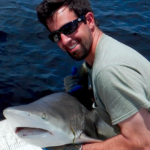 Joshua Moyer is an ichthyologist specializing in the evolution, biodiversity, and morphology of sharks and their relatives, collectively known as elasmobranchs. He is a member of the American Society of Ichthyologists and Herpetologists (ASIH) and the American Elasmobranch Society (AES). He has co-authored multiple scientific articles about shark teeth and their roles in understanding elasmobranch evolution. Joshua earned his Masters of Science in Ecology and Evolutionary Biology at Cornell University and teaches evolutionary biology at Ithaca College. Joshua also routinely lectures in courses on marine biology, vertebrate biology, and elasmobranchs. He has co-taught courses in shark biology in the field, laboratory, classroom, and most recently the online edX.org course “Sharks! Global Biodiversity, Biology, and Conservation.”
Joshua Moyer is an ichthyologist specializing in the evolution, biodiversity, and morphology of sharks and their relatives, collectively known as elasmobranchs. He is a member of the American Society of Ichthyologists and Herpetologists (ASIH) and the American Elasmobranch Society (AES). He has co-authored multiple scientific articles about shark teeth and their roles in understanding elasmobranch evolution. Joshua earned his Masters of Science in Ecology and Evolutionary Biology at Cornell University and teaches evolutionary biology at Ithaca College. Joshua also routinely lectures in courses on marine biology, vertebrate biology, and elasmobranchs. He has co-taught courses in shark biology in the field, laboratory, classroom, and most recently the online edX.org course “Sharks! Global Biodiversity, Biology, and Conservation.”
Whenever I tell someone that I study sharks I can see their imagination shift into high gear. Their eyebrows go up, their mouths make an intrigued smile, and I’m usually asked whether I’ve gone swimming with sharks or if I’ve ever been bitten by one. Yes, I’ve been in the water with sharks. No, a shark has never bitten me (although I did drop the jaw of a Mako shark on my arm once – that left an interesting scar). I’ve also gone on shark tagging trips and many spent days as an undergraduate documenting the social behaviors of sharks in aquaria. Those are what I call my “dinner party stories.” They’re the anecdotes people expect to hear from a shark biologist. I’m frequently happy to oblige. However, I’d be remiss if I didn’t acknowledge that oceanic adventures are not essential to being a shark biologist, and they’re no substitute for curiosity and educated observation. In other words, you may see a shark, but you need to know how to really look at it – how to study it.
Read More “Look at your sharks: how close observation leads to new scientific discoveries” »